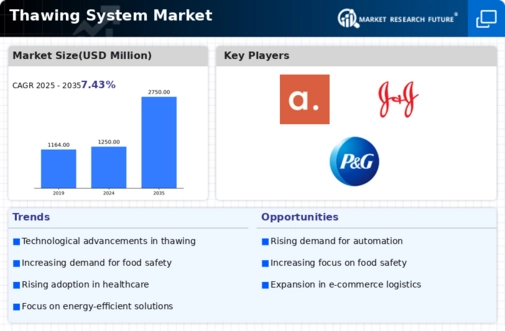Rising Demand for Frozen Foods
The Global Thawing System Market Industry experiences a notable surge in demand for frozen foods, driven by changing consumer preferences and lifestyles. As more individuals seek convenience in meal preparation, the consumption of frozen products continues to rise. In 2024, the market is valued at approximately 1250 USD Million, reflecting the growing inclination towards ready-to-eat meals. This trend is likely to propel the adoption of thawing systems, which are essential for maintaining food quality and safety. The increasing reliance on frozen foods suggests a robust growth trajectory for the thawing system market, as it aligns with the evolving dietary habits of consumers.
Consumer Awareness of Food Quality
Increasing consumer awareness regarding food quality and safety is a driving force in the Global Thawing System Market Industry. As consumers become more informed about the implications of improper thawing methods, they are more likely to seek products that utilize advanced thawing technologies. This heightened awareness encourages food manufacturers to invest in state-of-the-art thawing systems that ensure optimal food quality. The market's growth trajectory, projected at a CAGR of 7.43% from 2025 to 2035, reflects this shift in consumer behavior. As the demand for high-quality food products rises, the thawing system market is poised for substantial growth, aligning with consumer expectations.
Market Trends and Growth Projections
The Global Thawing System Market Industry is characterized by dynamic trends and growth projections that indicate a promising future. The market is expected to experience a significant increase in value, with estimates suggesting a rise from 1250 USD Million in 2024 to 2750 USD Million by 2035. This growth is underpinned by a compound annual growth rate (CAGR) of 7.43% from 2025 to 2035. The evolving landscape of food processing and consumer preferences is likely to shape the market, creating opportunities for innovation and expansion. As the industry adapts to these trends, stakeholders can anticipate a vibrant market environment.
Regulatory Standards for Food Safety
The Global Thawing System Market Industry is influenced by stringent regulatory standards aimed at ensuring food safety. Governments worldwide implement regulations that mandate proper thawing practices to prevent foodborne illnesses. Compliance with these regulations necessitates the use of efficient thawing systems that adhere to safety protocols. As food safety becomes a priority for both consumers and regulatory bodies, the demand for reliable thawing solutions is expected to rise. This regulatory landscape not only drives market growth but also encourages manufacturers to innovate and enhance their thawing technologies, thereby contributing to the overall expansion of the industry.
Growth of the Food Processing Industry
The expansion of the food processing industry significantly impacts the Global Thawing System Market Industry. As food processing facilities scale up operations to meet increasing consumer demand, the need for efficient thawing systems becomes paramount. The industry is witnessing a shift towards larger production capacities, necessitating advanced thawing solutions that can handle bulk quantities. This growth is reflected in the projected market value of 1250 USD Million in 2024, with expectations of reaching 2750 USD Million by 2035. The robust growth of the food processing sector indicates a sustained demand for thawing systems, as they are integral to maintaining product quality and safety during processing.
Technological Advancements in Thawing Systems
Technological innovations play a pivotal role in shaping the Global Thawing System Market Industry. The introduction of advanced thawing technologies, such as microwave and water immersion systems, enhances efficiency and reduces thawing time. These innovations not only improve food safety but also preserve the texture and flavor of thawed products. As the industry embraces automation and smart technologies, the market is projected to grow significantly. By 2035, the market is expected to reach 2750 USD Million, indicating a compound annual growth rate (CAGR) of 7.43% from 2025 to 2035. This growth underscores the importance of technology in meeting the demands of modern food processing.













